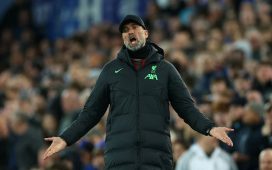
Of course, everyone’s sad now. The FA was sad. The PFA was sad. Jeremy Corbyn was sad. Chris off Love Island was sad. Of course, if you really wanted to reach for the superlatives, you could describe yourself as “devastated”, as did Debbie Jevans of the EFL. One person who didn’t seem all that sad, curiously enough, was Steve Dale. “I never went to Bury,” he admitted in the week that the club he owned was forced out of existence. “It’s not a place I frequented. For me to walk away from Bury and never go back is a very easy thing to do. I didn’t even know there was a football team called Bury, to be honest with you.”
And now, in large part thanks to Dale, there isn’t. On Wednesday, Bury became the first third-tier club in the history of English football to be forced out of existence, 124 years after it was first formed. There were tears outside Gigg Lane and anguish in the wider community. As for Dale, I suppose when 43 of the 51 companies you have been associated with over the years have been liquidated, perhaps you stop becoming emotionally attached to them after a while. Easy come, easy go – and all that.
For most sentient mammals, however, the sadness was the easy part. Mournful tweets poured forth. Solemn, sober pre-vetted solidarity statements were issued by rival clubs. Bury fans, meanwhile, may well be wondering why all this goodwill and sympathy only surfaced once their club was in its death throes, when their parlous financial situation had been plain to anyone who cared to look for years. Why only now, they might legitimately ask, has everyone decided to care about Bury?
The blunt truth is that football didn’t care. We in the media didn’t care enough about Bury to cover its plight. The EFL didn’t care enough about Bury to ensure that Dale had any more to spend on the club than the £1 with which he bought it. The population of Bury – almost 200,000, of whom about 2 per cent attended on Saturdays – didn’t care enough to show up. Successive Conservative governments didn’t care enough about Bury to spare its council from cuts of over 60 per cent, hampering its ability to offer assistance and accelerating the town’s wider economic decline. While Bury drowned, the game as a whole looked away. Now there is a corpse to stare at, everyone seems perfectly happy to gawp.
And once the gawping had ended, the finger-pointing could begin. Most notably at Dale and previous owner Stewart Day, but also at the wider regulatory system – such as it was – that allowed them to operate. At the EFL for failing to disqualify owners like Dale or Ken Anderson at Bolton, or institute financial rules that would prevent the vast majority of loss-making clubs from spending beyond their means. At the FA, too, for largely abdicating their responsibility for the running of club football.
1/92 English football’s most popular kits
Here are those 91 teams in order of popularity – with some surprising results. Which League Two team has released a set of kits even more popular than a high-flying Premier League club?
Getty
2/92 91. Forest Green Rovers
Getty Images
3/92 90. Bristol Rovers
Lowest League One team.
Getty Images
4/92 89. Peterborough United
CameraSport via Getty Images
5/92 88. Morecambe
Getty
6/92 87. Rochdale
Sunderland AFC via Getty Images
7/92 86. Gillingham
Getty Images
8/92 85. Crewe Alexander
Getty Images
9/92 84. Plymouth Argyle
Getty Images
10/92 83. Cheltenham Town
Getty Images
11/92 82. Macclesfield Town
Getty Images
12/92 81. Crawley Town
Action Images via Reuters
13/92 80. Fleetwood Town
CameraSport via Getty Images
14/92 79. Scunthorpe
Getty
15/92 78. Shrewsbury Town
Getty Images
16/92 77. Northampton Town
Arsenal FC via Getty Images
17/92 76. Swindon Town
Getty Images
18/92 75. Exeter City
Getty
19/92 74. Oldham Athletic
CameraSport via Getty Images
20/92 73. Walsall
Getty
21/92 72. Rotherham United
Getty Images
22/92 71. Southend United
CameraSport via Getty Images
23/92 70. Mansfield Town
Getty
24/92 69. Blackpool
CameraSport via Getty Images
25/92 68. Wycombe Wanderers
CameraSport via Getty Images
26/92 67. Carlisle United
Getty Images
27/92 66. Grimsby Town
PA
28/92 65. Barnsley
Lowest Championship team.
Getty Images
29/92 64. Colchester United
Action Images via Reuters
30/92 63. Preston North End
CameraSport via Getty Images
31/92 62. Doncaster Rovers
CameraSport via Getty Images
32/92 61. Milton Keynes Dons
CameraSport via Getty Images
33/92 60. Reading
Getty Images
34/92 59. Bolton Wanderers
Action Images via Reuters
35/92 58. Lincoln City
CameraSport via Getty Images
36/92 57. Oxford United
Action Images via Reuters
37/92 56. Brentford
PA
38/92 55. AFC Wimbledon
Sunderland AFC via Getty Images
39/92 54. Accrington Stanley
CameraSport via Getty Images
40/92 53. Port Vale
Getty Images
41/92 52. Wigan Athletic
CameraSport via Getty Images
42/92 51. Tranmere Rovers
PA
43/92 50. Ipswich Town
Sunderland AFC via Getty Images
44/92 49. Newport County
Action Images via Reuters
45/92 48. Luton Town
Getty Images
46/92 47. Cambridge United
Getty Images
47/92 46. Bradford City
PA
48/92 45. Leyton Orient
PA
49/92 44. Burton Albion
Action Images
50/92 43. Fulham
Getty Images
51/92 42. Coventry City
Getty Images
52/92 41. Portsmouth
Getty Images
53/92 40. Stevenage
Naomi Baker/Getty Images
54/92 39. Swansea City
Getty Images
55/92 38. Bournemouth
Lowest Premier League team.
AFC Bournemouth via Getty Images
56/92 37. Salford City
Highest League Two team.
Getty Images
57/92 36. West Bromwich Albion
PA
58/92 35. Millwall
Action Images via Reuters
59/92 34. Birmingham City
Getty Images
60/92 33. Sheffield Wednesday
Getty Images
61/92 32. Hull City
Getty Images
62/92 31. Blackburn Rovers
CameraSport via Getty Images
63/92 30. Queens Park Rangers
Getty Images
64/92 29. Middlesbrough
Getty Images
65/92 28. Brighton & Hove Albion
Getty Images
66/92 27. Charlton Athletic
Getty Images
67/92 26. Bristol City
Getty Images
68/92 25. Burnley
CameraSport via Getty Images
69/92 24. Cardiff City
Getty Images
70/92 23. Southampton
Getty Images
71/92 22. Watford
Action Images via Reuters
72/92 21. Sheffield United
Getty Images
73/92 20. Stoke City
CameraSport via Getty Images
74/92 19. Sunderland
Highest League One team.
Sunderland AFC via Getty Images
75/92 18. Norwich City
EPA
76/92 17. Crystal Palace
Getty Images
77/92 16. Nottingham Forest
Getty Images
78/92 15. Derby County
Getty Images
79/92 14, Leicester City
PA
80/92 13. Wolverhampton Wanderers
Getty Images
81/92 12. Everton
Everton FC via Getty Images
82/92 11. Leeds United
Getty Images
83/92 10. West Ham United
Getty Images
84/92 9. Newcastle United
PA
85/92 8. Aston Villa
Aston Villa FC via Getty Images
86/92 7. Tottenham Hotspur
Getty Images
87/92 6. Huddersfield Town
Highest Championship team.
Getty Images
88/92 5. Chelsea
Chelsea FC via Getty Images
89/92 4. Manchester City
REUTERS
90/92 3. Manchester United
Getty Images
91/92 2. Arsenal
Getty Images
92/92 1. Liverpool
The most popular set of kits in the country.
Liverpool FC via Getty Images
1/92 English football’s most popular kits
Here are those 91 teams in order of popularity – with some surprising results. Which League Two team has released a set of kits even more popular than a high-flying Premier League club?
Getty
2/92 91. Forest Green Rovers
Getty Images
3/92 90. Bristol Rovers
Lowest League One team.
Getty Images
4/92 89. Peterborough United
CameraSport via Getty Images
5/92 88. Morecambe
Getty
6/92 87. Rochdale
Sunderland AFC via Getty Images
7/92 86. Gillingham
Getty Images
8/92 85. Crewe Alexander
Getty Images
9/92 84. Plymouth Argyle
Getty Images
10/92 83. Cheltenham Town
Getty Images
11/92 82. Macclesfield Town
Getty Images
12/92 81. Crawley Town
Action Images via Reuters
13/92 80. Fleetwood Town
CameraSport via Getty Images
14/92 79. Scunthorpe
Getty
15/92 78. Shrewsbury Town
Getty Images
16/92 77. Northampton Town
Arsenal FC via Getty Images
17/92 76. Swindon Town
Getty Images
18/92 75. Exeter City
Getty
19/92 74. Oldham Athletic
CameraSport via Getty Images
20/92 73. Walsall
Getty
21/92 72. Rotherham United
Getty Images
22/92 71. Southend United
CameraSport via Getty Images
23/92 70. Mansfield Town
Getty
24/92 69. Blackpool
CameraSport via Getty Images
25/92 68. Wycombe Wanderers
CameraSport via Getty Images
26/92 67. Carlisle United
Getty Images
27/92 66. Grimsby Town
PA
28/92 65. Barnsley
Lowest Championship team.
Getty Images
29/92 64. Colchester United
Action Images via Reuters
30/92 63. Preston North End
CameraSport via Getty Images
31/92 62. Doncaster Rovers
CameraSport via Getty Images
32/92 61. Milton Keynes Dons
CameraSport via Getty Images
33/92 60. Reading
Getty Images
34/92 59. Bolton Wanderers
Action Images via Reuters
35/92 58. Lincoln City
CameraSport via Getty Images
36/92 57. Oxford United
Action Images via Reuters
37/92 56. Brentford
PA
38/92 55. AFC Wimbledon
Sunderland AFC via Getty Images
39/92 54. Accrington Stanley
CameraSport via Getty Images
40/92 53. Port Vale
Getty Images
41/92 52. Wigan Athletic
CameraSport via Getty Images
42/92 51. Tranmere Rovers
PA
43/92 50. Ipswich Town
Sunderland AFC via Getty Images
44/92 49. Newport County
Action Images via Reuters
45/92 48. Luton Town
Getty Images
46/92 47. Cambridge United
Getty Images
47/92 46. Bradford City
PA
48/92 45. Leyton Orient
PA
49/92 44. Burton Albion
Action Images
50/92 43. Fulham
Getty Images
51/92 42. Coventry City
Getty Images
52/92 41. Portsmouth
Getty Images
53/92 40. Stevenage
Naomi Baker/Getty Images
54/92 39. Swansea City
Getty Images
55/92 38. Bournemouth
Lowest Premier League team.
AFC Bournemouth via Getty Images
56/92 37. Salford City
Highest League Two team.
Getty Images
57/92 36. West Bromwich Albion
PA
58/92 35. Millwall
Action Images via Reuters
59/92 34. Birmingham City
Getty Images
60/92 33. Sheffield Wednesday
Getty Images
61/92 32. Hull City
Getty Images
62/92 31. Blackburn Rovers
CameraSport via Getty Images
63/92 30. Queens Park Rangers
Getty Images
64/92 29. Middlesbrough
Getty Images
65/92 28. Brighton & Hove Albion
Getty Images
66/92 27. Charlton Athletic
Getty Images
67/92 26. Bristol City
Getty Images
68/92 25. Burnley
CameraSport via Getty Images
69/92 24. Cardiff City
Getty Images
70/92 23. Southampton
Getty Images
71/92 22. Watford
Action Images via Reuters
72/92 21. Sheffield United
Getty Images
73/92 20. Stoke City
CameraSport via Getty Images
74/92 19. Sunderland
Highest League One team.
Sunderland AFC via Getty Images
75/92 18. Norwich City
EPA
76/92 17. Crystal Palace
Getty Images
77/92 16. Nottingham Forest
Getty Images
78/92 15. Derby County
Getty Images
79/92 14, Leicester City
PA
80/92 13. Wolverhampton Wanderers
Getty Images
81/92 12. Everton
Everton FC via Getty Images
82/92 11. Leeds United
Getty Images
83/92 10. West Ham United
Getty Images
84/92 9. Newcastle United
PA
85/92 8. Aston Villa
Aston Villa FC via Getty Images
86/92 7. Tottenham Hotspur
Getty Images
87/92 6. Huddersfield Town
Highest Championship team.
Getty Images
88/92 5. Chelsea
Chelsea FC via Getty Images
89/92 4. Manchester City
REUTERS
90/92 3. Manchester United
Getty Images
91/92 2. Arsenal
Getty Images
92/92 1. Liverpool
The most popular set of kits in the country.
Liverpool FC via Getty Images
It was all correct, and yet at the same time, none of it really was. The EFL is really more of a custodian than an executive body, run by and thus exclusively serving the whims of its 72 clubs. With isolated exceptions like Andy Holt at Accrington Stanley, those clubs have fiercely rejected any further regulation of their businesses. Calling for the FA or an independent body to be given greater regulatory powers is all very well until you ask where that power will be taken from: presumably the Premier League and the EFL, who have traditionally been extremely amenable to external oversight. Asking central government to step up and take the lead feels superficially seductive, but given that parliament is currently being held to ransom by an animatronic blonde scarecrow and his boiled-egg sidekick, perhaps it’s asking a little too much of their collective competence to undo more than three decades of deregulated free-market capitalism.
And so while the tale of Bury’s demise may strike you first and foremost as one of capital, of who gets it and who gets to assert it, more specifically it’s about power, and who gets to wield it. The two are inextricably intertwined, of course, but they’re not one and the same thing. As owners up and down the country have discovered, you can buy a football club, you can buy its deeds and its assets, its seats and its laser printers and every pot of paint in the store cupboard. But you can’t buy the time or the silence of the people who support it.
Fan power failed to save Bury. But perhaps the stark shock of seeing a football club vanishing into thin air – pffff, gone – and the yawning tragedy of the void it leaves behind, will jolt others into action. It’s Bury this week, but it could easily have been Bolton or Charlton, Coventry or Blackpool, Oldham or Morecambe or Sunderland or Reading or Ipswich or Birmingham or Macclesfield or Leeds or dozens of others. In order to heed the warning of Bury, however, it’ll require a realisation. It’ll need the millions of good people in English football to recognise that the fate of every club is tied to the fate of every other club, that if one goes we all lose, and to organise and co-operate and militate as never before.
The idea of fans uniting across traditional club boundaries has been cautiously explored of late. A few years ago, Charlton and Coventry fans memorably held a joint march ahead of their league game in protest at their generally useless owners. This week, fans of Liverpool, Chelsea, Arsenal and Tottenham signed a joint letter to Uefa demanding better treatment of fans at major European finals. Meanwhile the Football Supporters’ Association – itself the result of a merger between the FSF and Supporters’ Direct – has called on crowds this weekend to hold a minute’s applause in the 27th minute in “a nationwide display of solidarity for Bury”.
Imagine if this idea were taken beyond tentative gestures and to its logical conclusion. Imagine if an entire round of fixtures were played out in empty stadiums as a result of a concerted nationwide protest. Imagine the pressure that could be exerted on rogue owners by organised boycotts of the companies they run. Imagine if deeply unpopular initiatives like the EPPP, or the B-team Checkatrade Trophy, could be derailed by sustained campaigns and direct action, rather than simply a crowdfunded banner or a few disgruntled calls to Talksport.
It’s too late to mourn what has been lost. The gales of the market, the spivs and the charlatans, are running riot through English football, and if there’s to be any sort of silver lining to the utter travesty of Bury, perhaps it will be to focus minds. To unite those who believe that football clubs are more than businesses to be run into the ground, to force home the bitter truth that sadness won’t avert the next casualty, that the mismanagement of the game requires synchronised action rather than sweet words, and that no fanbase, however large or vocal, can do any of this on its own. It’s no comfort at all to the tearful fans pinning their scarves and messages outside Gigg Lane, but perhaps Bury died so others may live.














